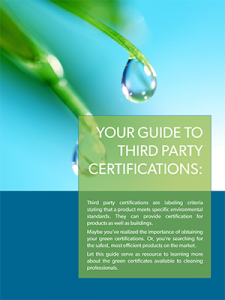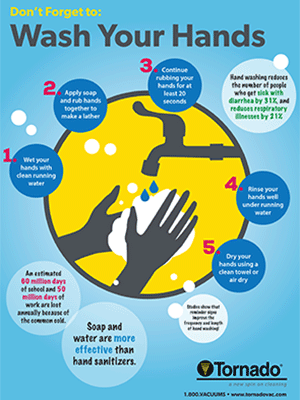Back to School: Cleaning for Health
Streak-free windows and spotless floors are certainly important, but aesthetics aren’t the primary purpose for cleaning. More important is the role janitors play in protecting the health of a building’s occupant—and nowhere does this matter more than in the education market. Make sure you’re doing all you can to keep kids healthy with this guide to cleaning for health in the school setting.
Why It Matters
Children go to school to learn and grow, and good health is fundamental to their development. Missed school days caused by infection or poor indoor air quality have a profoundly negative effect on educational achievement.
The numbers are staggering. Infectious diseases cause millions of lost school days each year for K-12 students, according to the Centers for Disease Control and Prevention (CDC)”
- Students average 4.5 illness-related absences per school year (teachers average 5.3)
- 40 percent of 5-to-17 year olds missed 3 or more school days last year because of illness or injury
- 22 million school days are lost each year due to colds
- 38 million school days are lost each year due to the influenza virus
- The cost of all those missed days is about $120 billion per year
Infection Control
Controlling the spread of germs among students and staff is a major priority for a school. When you have a lot of children together in a small space, viruses and bacterial infections can spread like wildfire.
The first step in prevention is creating an Infection Control Plan (ICP) with procedures to cut down the risk of transmission. While some of this plan is in the hands of administrators or the school nurse (ie, vaccination requirements), the cleaning staff should take the lead on many other elements:
Encourage Hand Hygiene
The most effective way to slow the spread of infection? Simply washing your hands. Getting kids to do it—and do it properly—can be a challenge. Remove some of the barriers to hand hygiene by ensuring bathrooms are always well stocked with soap, paper towels and/or working hand dryers. Reminder and instructional signs hung at a child’s eye level near the sinks are also helpful. It’s also smart to offer hand sanitizing stations in classrooms and other areas where a sink isn’t immediately available.
“If God spoke to me by saying, ‘Mark, you’re down to your last three words: What would you want to say to your fellow humans that would make the most positive impact?’ It would be a close call between Love Thy Neighbor and … Wash Your Hands”
Reminding building occupants about proper hand washing can go a long way.
Studies show that reminder signs do improve the frequency and length of hand washing. Download our free hand washing poster. Incorporate your logo and hand it out to customers!
Control Cross-Contamination
Children are good at spreading germs themselves—don’t help them! Moving pathogens from one area of the school to another with contaminated water or cleaning tools is a common problem, but it can be addressed with good planning and training. Purchase color-coded cloths, mops, and buckets, and then train staff on their proper use. Microfiber mop heads can be changed in each room or after cleaning high-risk areas, like restrooms. If you use cotton mops, invest in a dual-bucket system; one contains fresh cleaning water and the other is for wringing out the mop to keep dirty water from being reapplied to the floor. Better yet, employing automatic scrubbers, which lay clean solution down, scrub the floors, and then recover the dirty solution into a separate recovery tank in a single pass, is one of the best ways to avoid cross-contamination.
In carpeted areas, vacuums should always be equipped with HEPA filters, which help contain dirt and allergens recovered inside the filter compartment of the vacuum, preventing cross-contaimation of surrounding surfaces. In addition, hot water carpet extractors should be employed on a regular schedule to flush the carpet of soils and contaminants.
Disinfect during outbreaks
Hundreds of little fingers and millions of tiny germs may share the same items in the course of a single school day. Regular cleaning of surfaces is typically sufficient, but during an outbreak of flu, Norovirus, strep, or other contagious infection, disinfecting becomes necessary. Choose an EPA-registered quatinary-based product that includes a Norovirus kill claim. Training is very important with these products to ensure they are effective and safe.
Germ hotspots:
- All restroom surfaces
- Tabletops in classrooms and cafeterias
- Doorknobs
- Pencil sharpeners
- Keyboards
- Water fountain buttons
- Telephones
- Light switch plates
Deal with body fluid spills
It’s not pleasant, but anyone cleaning a school will eventually have to deal with body fluids. School districts often have specific policies for this situation, so educate yourself on the clean-up procedures and train all staff regularly. The Occupational Health and Safety Administration’s Bloodborne Pathogens Standard applies to all workers who come into contact with body fluids on the job, so it’s also a good idea to familiarize yourself with the requirements. Clean up kits for body fluid spills should be prepared ahead of time and available for use at a moment’s notice.
The Green Effect
Controlling infection in schools is half the battle, but also important is using safer products. That’s why green cleaning is a cornerstone of cleaning for health. It’s not just better for the environment, it can also dramatically improve the health of building occupants.
Asthma is one of the leading causes of school absenteeism, and it’s one of the most common chronic illnesses in young people. Asthma and other respiratory conditions can be triggered by airborne pollutants, such as cleaning sprays, air fresheners, and fumes. In fact, exposure to the toxins in these chemicals can be dangerous even to children and adults without a diagnosed illness.
To protect your school population, choose environmentally friendly products. This is already a requirement (or strong suggestion) in 11 states and the District of Columbia. Buyer beware: Not all green products are created equal. When choosing a product, look for independent third-party certification, such as the EPA’s Safer Choice, Green Seal or UL Eco Logo.

Download your guide to Green Certifications!
Not so long ago, green cleaning was far from a priority for many in the industry. Times have changed dramatically.
Let this guide serve as a resource to learning more about the green certificates available to cleaning professionals.
It’s also a good idea to switch from cotton to microfiber cloths and mops. This high-tech material does a superior job of removing microscopic particles, rather than moving them around. Plus, studies have found switching to microfiber mops can lead to a 95 precent reduction in the use of chemicals.
Finally, consider automating cleaning as much as possible through the use of powered cleaning equipment. Units like backpack vacuums with HEPA filters, which are available in both electric and battery models, are an excellent alternative to hand dusting and even sweeping or dust mopping. Automatic scrubbers, which are now available in micro and compact sizes for use in even the tightest areas, are more often than not a better choice in school settings than hand mops.
A Note About Disinfectants
There’s no green certification for disinfectants at this time, so they should be used judiciously and with great care. The Environmental Protection Agency (EPA) offers a comprehensive set of resources on green cleaning, sanitizing, and disinfecting in Early Childhood Education, which are still relevant as children move into K-12.
These materials discuss the risks, concerns, and considerations of using chemical products in childhood environments. In some situations, such as infection control, the use of chemical disinfecting agents may be unavoidable. They key is to target your disinfectant use to high-risk areas. Wherever possible, restrict disinfectant use to after school hours to limit students’ exposure.
Helpful Resources
Cleaning For Healthy Schools and Green Clean Schools offer detailed toolkits for administrators and janitorial staff, with resources related to developing and implementing healthy cleaning plans, training staff in safe cleaning practices, choosing safer products, and much more.


